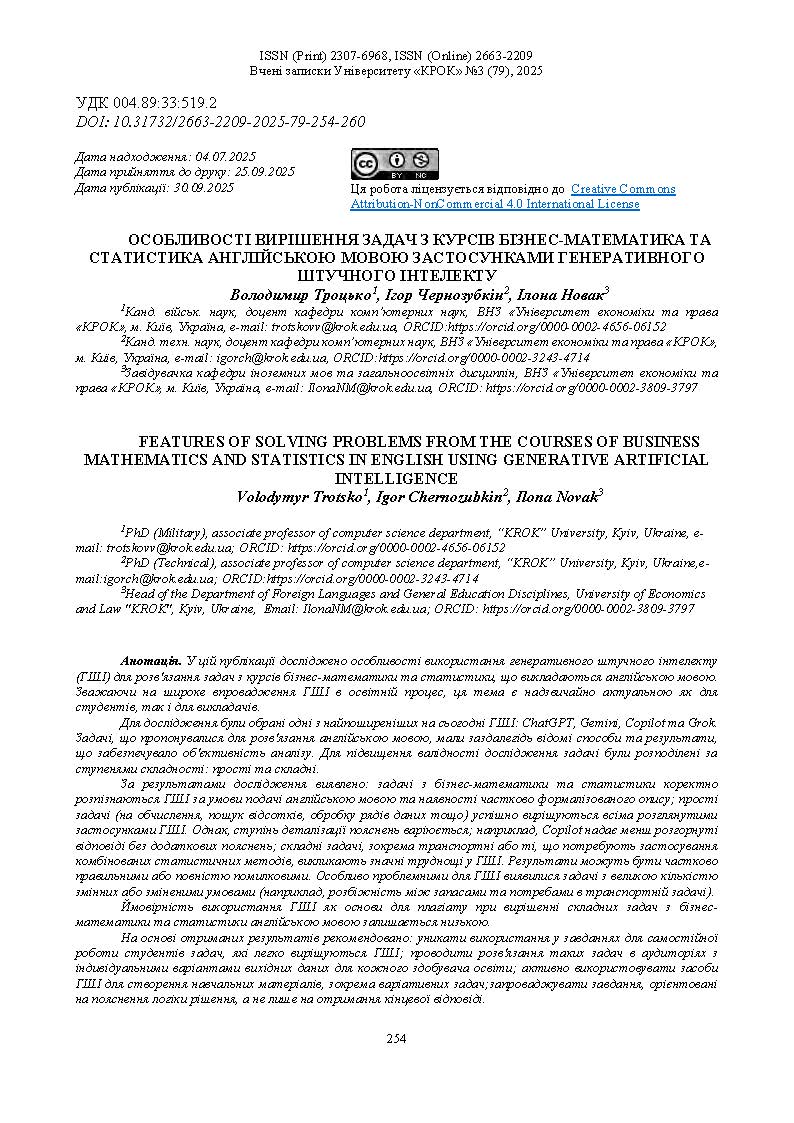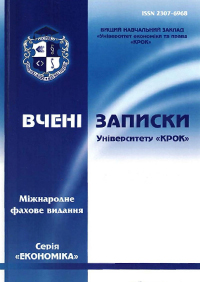ОСОБЛИВОСТІ ВИРІШЕННЯ ЗАДАЧ З КУРСІВ БІЗНЕС-МАТЕМАТИКА ТА СТАТИСТИКА АНГЛІЙСЬКОЮ МОВОЮ ЗАСТОСУНКАМИ ГЕНЕРАТИВНОГО ШТУЧНОГО ІНТЕЛЕКТУ
DOI:
https://doi.org/10.31732/2663-2209-2025-79-254-260Ключові слова:
генеративний штучний інтелект, бізнес-математика, статистика, англійська мова, постплагіатАнотація
У цій публікації досліджено особливості використання генеративного штучного інтелекту (ГШІ) для розв'язання задач з курсів бізнес-математики та статистики, що викладаються англійською мовою. Зважаючи на широке впровадження ГШІ в освітній процес, ця тема є надзвичайно актуальною як для студентів, так і для викладачів.
Для дослідження були обрані одні з найпоширеніших на сьогодні ГШІ: ChatGPT, Gemini, Copilot та Grok. Задачі, що пропонувалися для розв'язання англійською мовою, мали заздалегідь відомі способи та результати, що забезпечувало об'єктивність аналізу. Для підвищення валідності дослідження задачі були розподілені за ступенями складності: прості та складні.
За результатами дослідження виявлено: задачі з бізнес-математики та статистики коректно розпізнаються ГШІ за умови подачі англійською мовою та наявності частково формалізованого опису; прості задачі (на обчислення, пошук відсотків, обробку рядів даних тощо) успішно вирішуються всіма розглянутими застосунками ГШІ. Однак, ступінь деталізації пояснень варіюється; наприклад, Copilot надає менш розгорнуті відповіді без додаткових пояснень; складні задачі, зокрема транспортні або ті, що потребують застосування комбінованих статистичних методів, викликають значні труднощі у ГШІ. Результати можуть бути частково правильними або повністю помилковими. Особливо проблемними для ГШІ виявилися задачі з великою кількістю змінних або зміненими умовами (наприклад, розбіжність між запасами та потребами в транспортній задачі).
Ймовірність використання ГШІ як основи для плагіату при вирішенні складних задач з бізнес-математики та статистики англійською мовою залишається низькою.
На основі отриманих результатів рекомендовано: уникати використання у завданнях для самостійної роботи студентів задач, які легко вирішуються ГШІ; проводити розв'язання таких задач в аудиторіях з індивідуальними варіантами вихідних даних для кожного здобувача освіти; активно використовувати засоби ГШІ для створення навчальних матеріалів, зокрема варіативних задач;запроваджувати завдання, орієнтовані на пояснення логіки рішення, а не лише на отримання кінцевої відповіді.
Завантаження
Посилання
Awang, L. A., Yusop, F. D., & Danaee, M. (б.д.). Current practices and future direction of artificial intelligence in mathematics education: A systematic review. https://www.iejme.com/download/current-practices-and-future-direction-of-artificial-intelligence-in-mathematics-education-a-16006.pdf
Бойко, В. М. (2022). Сучасні технології навчання бізнес-математики в університеті. Видавництво КНУ.
Castillo, R. (2015). Transportation Problem. https://www.researchgate.net/publication/319393263_Transportation_Problem
Eaton International Journal for Educational Integrity. (2025). https://doi.org/10.1007/s40979-025-00187-6
Gabriel, F., Kennedy, J. P., Marrone, R., & Leonard, S. (б.д.). Pragmatic AI in education and its role in mathematics learning and teaching. https://www.nature.com/articles/s41539-025-00315-4
Holmes, A., Illowsky, B., & Dean, S. (б.д.). Introductory Business Statistics. https://openlibrary-repo.ecampusontario.ca/jspui/bitstream/123456789/486/1/introductory-business-statistics-33.86.pdf
Ковальчук, І. П. (2023). Використання штучного інтелекту в освіті: перспективи для викладання математики і статистики. Вісник Київського університету. Серія «Педагогіка і психологія», (74), 58–66.
Мельник, Т. В. (2024). Використання комп’ютерних додатків у курсі статистики для студентів економічних спеціальностей. Науковий вісник НЛТУ України, 34(1), 105–112.
Olivier, J.-P. (б.д.). Business Math a Step-by-Step Handbook 2023-A-D. Lyryx Learning Inc. https://collection.bccampus.ca/textbooks/business-math-a-step-by-step-handbook-2023-a-d-lyryx-learning-inc-447/
Ramki, H. (б.д.). The 21 best generative AI tools in 2025. Zapier. https://zapier.com/blog/generative-ai-tools/
Штучний інтелект у вищій освіті: ризики та перспективи інтеграції. (2024, липень 1 – серпень 11). Матеріали всеукраїнського науково-педагогічного підвищення кваліфікації. https://cuesc.org.ua/images/informlist/%D0%9C%D0%B0%D0%BA%D0%B5%D1%82%20advanced_training_OLA.pdf

Downloads
Опубліковано
Як цитувати
Номер
Розділ
Ліцензія

Ця робота ліцензується відповідно до Creative Commons Attribution-NonCommercial 4.0 International License.

